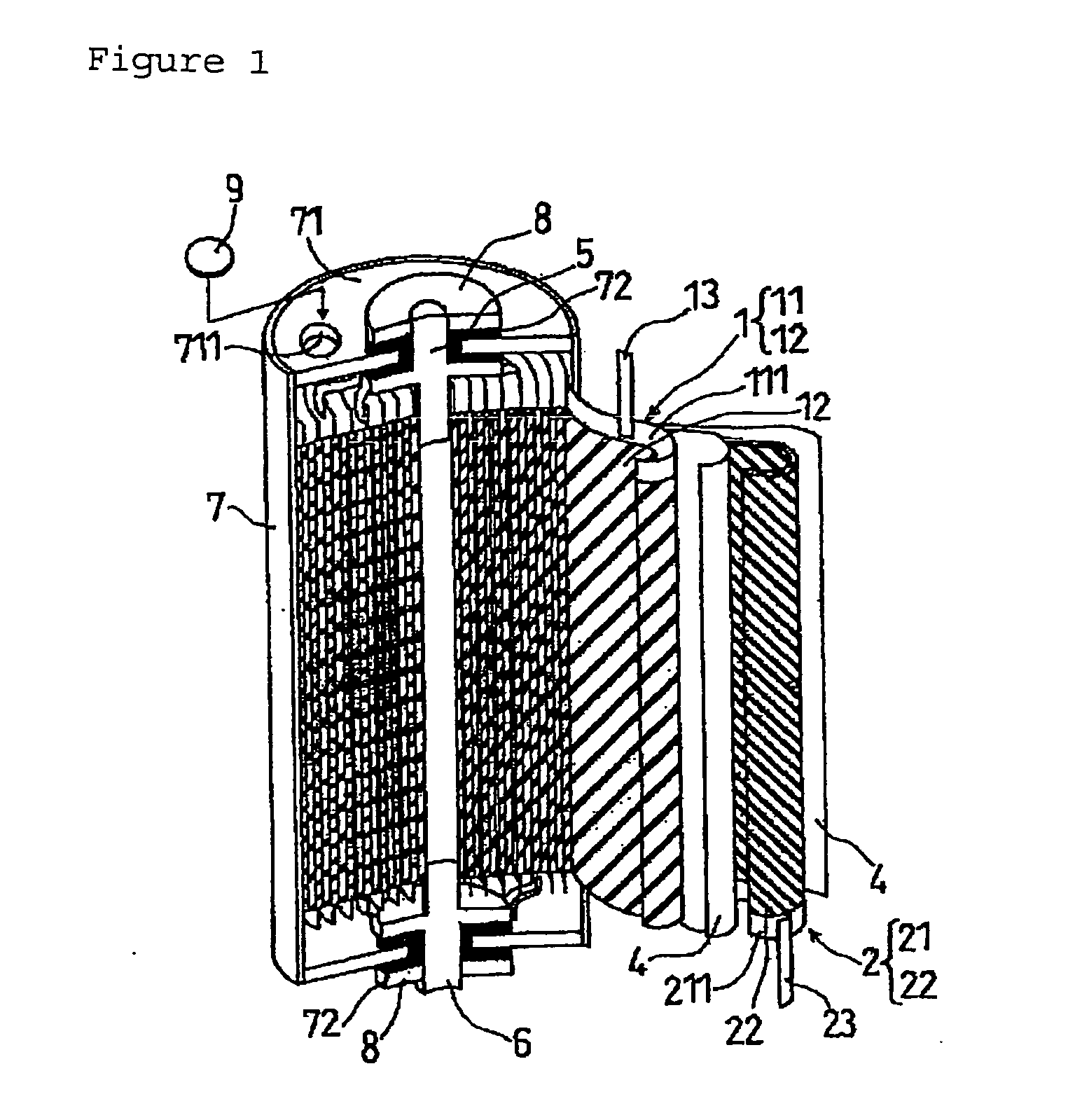Separator for battery and lithium ion battery using the same
a lithium ion battery and separator technology, applied in the field of battery separators, can solve the problems of insufficient strength, difficult production of porous films from high-melting point resins, and insufficient strength of nonwoven fabric separators, and achieve excellent heat resistance and insulating properties, low cost, and good heat dissipation
- Summary
- Abstract
- Description
- Claims
- Application Information
AI Technical Summary
Benefits of technology
Problems solved by technology
Method used
Image
Examples
example 1
[0057] A 4-methyl-1-pentene copolymer (trade name: TPX DX820 manufactured by Mitsui Chemicals, Inc., melting point: 240° C., melt flow rate at 260° C. and 5 kg load: 180 g / 10 min) was spun by a meltblowing method at a resin temperature of 350° C. and a spinning air rate (amount of air used for spinning 1 kg of resin) of 60 Nm3 / kg, and the fibers were collected on a web former to give a nonwoven fabric web with a basis weight of 10 g / m2. The average fiber diameter of the nonwoven fabric web was 1.4 μm. The nonwoven fabric web obtained was pressed with a calender roll apparatus that included a rubber roll having a surface temperature of 150° C. (elastic modulus: 300 kg / cm2) and a steel roll having a surface temperature of 180° C. Thus, a lithium ion battery separator having properties shown in Table 1 was obtained.
[0058] Subsequently, a lithium ion secondary battery illustrated in FIG. 1 was manufactured using the lithium ion battery separator as described below.
[0059] A positive el...
example 2
[0063] A 4-methyl-1-pentene copolymer (trade name: TPX DX820 manufactured by Mitsui Chemicals, Inc., melting point: 240° C., melt flow rate at 260° C. and 5 kg load: 180 g / 10 min) was spun by a meltblowing method at a resin temperature of 340° C. and a spinning air rate (amount of air used for spinning 1 kg of resin) of 60 Nm3 / kg, and the fibers were collected on a web former to give a nonwoven fabric web with a basis weight of 15 g / m2. The average fiber diameter of the nonwoven fabric web was 2.6 μm. The nonwoven fabric web obtained was pressed with a calender roll apparatus that included a rubber roll having a surface temperature of 150° C. (elastic modulus: 300 kg / cm2) and a steel roll having a surface temperature of 180° C. Thus, a lithium ion battery separator having properties shown in Table 1 was obtained.
[0064] Subsequently, a lithium ion secondary battery illustrated in FIG. 1 was manufactured as described in Example 1, using the lithium ion battery separator obtained abov...
example 3
[0065] A 4-methyl-1-pentene copolymer (trade name: TPX DX820 manufactured by Mitsui Chemicals, Inc., melting point: 240° C., melt flow rate at 260° C. and 5 kg load: 180 g / 10 min) was spun by a meltblowing method at a resin temperature of 340° C. and a spinning air rate (amount of air used for spinning 1 kg of resin) of 60 Nm3 / kg, and the fibers were collected on a web former to give a nonwoven fabric web with a basis weight of 21 g / m2. The average fiber diameter of the nonwoven fabric web was 2.4 μm. The nonwoven fabric web obtained was pressed with a calender roll apparatus that included a rubber roll having a surface temperature of 150° C. (elastic modulus: 300 kg / cm2) and a steel roll having a surface temperature of 180° C. Thus, a lithium ion secondary battery separator having properties shown in Table 1 was obtained.
[0066] Subsequently, a lithium ion secondary battery illustrated in FIG. 1 was manufactured as described in Example 1, using the lithium ion battery separator obt...
PUM
| Property | Measurement | Unit |
|---|---|---|
| Length | aaaaa | aaaaa |
| Length | aaaaa | aaaaa |
| Frequency | aaaaa | aaaaa |
Abstract
Description
Claims
Application Information
 Login to View More
Login to View More - R&D
- Intellectual Property
- Life Sciences
- Materials
- Tech Scout
- Unparalleled Data Quality
- Higher Quality Content
- 60% Fewer Hallucinations
Browse by: Latest US Patents, China's latest patents, Technical Efficacy Thesaurus, Application Domain, Technology Topic, Popular Technical Reports.
© 2025 PatSnap. All rights reserved.Legal|Privacy policy|Modern Slavery Act Transparency Statement|Sitemap|About US| Contact US: help@patsnap.com


